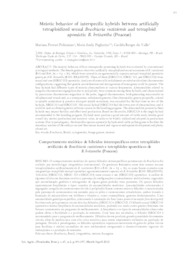Meiotic behavior of interspecific hybrids between artificially tetraploidized sexual Brachiaria ruziziensis and tetraploid apomictic B. brizantha (Poaceae).
Meiotic behavior of interspecific hybrids between artificially tetraploidized sexual Brachiaria ruziziensis and tetraploid apomictic B. brizantha (Poaceae).
Author(s): FELISMINO, M. F.; PAGLIARINI, M. S.; VALLE, C. B. do
Summary: ABSTRACT -The meiotic behavior of four interspecific promising hybrids was evaluated by conventional cytological methods. The female genitors were two artificially tetraploidized sexual accessions of B. ruziziensis (R41 and R44, 2n = 4 ? = 36), which were crossed to an agronomically superior natural tetraploid apomictic genotype of B. brizantha (B140 - BRA003395). Three of them (HBGC313, HBGC 315, and HBGC324) were sexual and one (HBGC325) apomictic. Analyses of some cells in diakinesis revealed multivalent chromosome configurations, suggesting that genetic recombination and introgression of some genes could be present. The four hybrids had different types of meiotic abnormalities at various frequencies. Abnormalities related to irregular chromosome segregation due to polyploidy were common among these hybrids, and characterized by precocious chromosome migration to the poles, laggard chromosomes, both generating micronuclei in telophases and tetrads and, as a consequence, unbalanced gametes. One abnormality genotype-specific, related to spindle orientation (a putative divergent spindle mutation), was recorded for the first time in two of the hybrids, HBGC313 and HBGC325. The sexual hybrid HBGC324 had the lower rate of abnormalities, and it could be used as a female genitor in future crosses in the breeding program. The abnormalities present in these hybrids may impact fertility and affect seed production. Based on the results, HBGC324 is the single hybrid recommended to the breeding program. Hybrids must produce a good amount of viable seeds, besides good overall dry matter production and nutritive value, in order to be widely utilized and adopted in production systems. Due to pseudogamy, the desirable superior apomictic hybrids need viable pollen grains to fertilize the secondary nucleus of the embryo sac and thus ensure normal and vigorous endosperm development and plenty of seed set.
Publication year: 2010
Types of publication: Journal article
Unit: Embrapa Beef Cattle
Observation
Some of Embrapa's publications are published as ePub files. To read them, use or download one of the following free software options to your computer or mobile device. Android: Google Play Books; IOS: iBooks; Windows and Linux: Calibre.
Access other publications
Access the Agricultural Research Database (BDPA) to consult Embrapa's full library collection and records.
Visit Embrapa Bookstore to purchase books and other publications sold by Embrapa.

